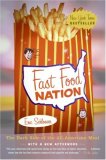Summary | Excerpt | Reading Guide | Reviews | Readalikes | Genres & Themes | Author Bio

Critics' Opinion:
Readers' Opinion:
First Published:
Jan 2001, 288 pages
Paperback:
Jan 2002, 384 pages
What we eat
OVER THE LAST THREE DECADES, fast food has infiltrated every nook and cranny of American society. An industry that began with a handful of modest hot dog and hamburger stands in southern California has spread to every corner of the nation, selling a broad range of foods wherever paying customers may be found. Fast food is now served at restaurants and drive-throughs, at stadiums, airports, zoos, high schools, elementary schools, and universities, on cruise ships, trains, and airplanes, at K-Marts, Wal-Marts, gas stations, and even at hospital cafeterias. In 1970, Americans spent about $6 billion on fast food; in 2000, they spent more than $110 billion. Americans now spend more money on fast food than on higher education, personal computers, computer software, or new cars. They spend more on fast food than on movies, books, magazines, newspapers, videos, and recorded music — combined.
Pull open the glass door, feel the rush of cool air, walk in, get on line, study the backlit color photographs above the counter, place your order, hand over a few dollars, watch teenagers in uniforms pushing various buttons, and moments later take hold of a plastic tray full of food wrapped in colored paper and cardboard. The whole experience of buying fast food has become so routine, so thoroughly unexceptional and mundane, that it is now taken for granted, like brushing your teeth or stopping for a red light. It has become a social custom as American as a small, rectangular, hand-held, frozen, and reheated apple pie.
This is a book about fast food, the values it embodies, and the world it has made. Fast food has proven to be a revolutionary force in American life; I am interested in it both as a commodity and as a metaphor. What people eat (or don’t eat) has always been determined by a complex interplay of social, economic, and technological forces. The early Roman Republic was fed by its citizen-farmers; the Roman Empire, by its slaves. A nation’s diet can be more revealing than its art or literature. On any given day in the United States about one-quarter of the adult population visits a fast food restaurant. During a relatively brief period of time, the fast food industry has helped to transform not only the American diet, but also our landscape, economy, workforce, and popular culture. Fast food and its consequences have become inescapable, regardless of whether you eat it twice a day, try to avoid it, or have never taken a single bite.
The extraordinary growth of the fast food industry has been driven by fundamental changes in American society. Adjusted for inflation, the hourly wage of the average U.S. worker peaked in 1973 and then steadily declined for the next twenty-five years. During that period, women entered the workforce in record numbers, often motivated less by a feminist perspective than by a need to pay the bills. In 1975, about one-third of American mothers with young children worked outside the home; today almost two-thirds of such mothers are employed. As the sociologists Cameron Lynne Macdonald and Carmen Sirianni have noted, the entry of so many women into the workforce has greatly increased demand for the types of services that housewives traditionally perform: cooking, cleaning, and child care. A generation ago, three-quarters of the money used to buy food in the United States was spent to prepare meals at home. Today about half of the money used to buy food is spent at restaurants — mainly at fast food restaurants.
The McDonald’s Corporation has become a powerful symbol of America’s service economy, which is now responsible for 90 percent of the country’s new jobs. In 1968, McDonald’s operated about one thousand restaurants. Today it has about twenty-eight thousand restaurants worldwide and opens almost two thousand new ones each year. An estimated one out of every eight workers in the United States has at some point been employed by McDonald’s. The company annually hires about one million people, more than any other American organization, public or private. McDonald’s is the nation’s largest purchaser of beef, pork, and potatoes — and the second largest purchaser of chicken. The McDonald’s Corporation is the largest owner of retail property in the world. Indeed, the company earns the majority of its profits not from selling food but from collecting rent. McDonald’s spends more money on advertising and marketing than any other brand. As a result it has replaced Coca-Cola as the world’s most famous brand. McDonald’s operates more playgrounds than any other private entity in the United States. It is one of the nation’s largest distributors of toys. A survey of American schoolchildren found that 96 percent could identify Ronald McDonald. The only fictional character with a higher degree of recognition was Santa Claus. The impact of McDonald’s on the way we live today is hard to overstate. The Golden Arches are now more widely recognized than the Christian cross.
Copyright © 2000 Eric Schlosser. Reprinted by permission of Houghton Mifflin Company.





The House on Biscayne Bay
by Chanel Cleeton
As death stalks a gothic mansion in Miami, the lives of two women intertwine as the past and present collide.

The Flower Sisters
by Michelle Collins Anderson
From the new Fannie Flagg of the Ozarks, a richly-woven story of family, forgiveness, and reinvention.

The Funeral Cryer by Wenyan Lu
Debut novelist Wenyan Lu brings us this witty yet profound story about one woman's midlife reawakening in contemporary rural China.
Your guide toexceptional books
BookBrowse seeks out and recommends the best in contemporary fiction and nonfiction—books that not only engage and entertain but also deepen our understanding of ourselves and the world around us.